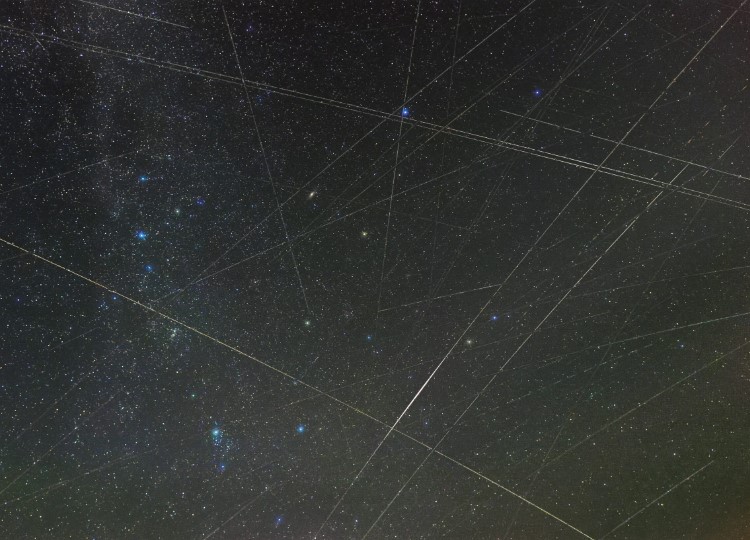
In a dazzling display of technological prowess, SpaceX’s Falcon 9 rocket soared into the night sky, carrying with it 22 Starlink satellites destined for low-Earth orbit. The launch, which occurred at 11:38 p.m. EDT from Cape Canaveral Space Force Station in Florida, marked a significant milestone in SpaceX’s ambitious mission to blanket the globe with high-speed internet access. This successful liftoff, SpaceX’s 65th launch of the year, came after an initial attempt on Thursday night was scrubbed, underscoring the meticulous planning and execution required for such feats of space exploration.
The Falcon 9 rocket that propelled this payload into orbit had already etched its name in the annals of space history, having undertaken four previous missions, including Crew-6, SES O3b mPOWER, and two earlier Starlink missions. Its successful reuse showcases SpaceX’s commitment to making spaceflight more cost-effective and sustainable through the development of reusable rocket technology.
The culmination of this launch was the flawless landing of the Falcon 9’s first stage aboard SpaceX’s drone ship, aptly named “Just Read the Instructions,” positioned in the vast expanse of the Atlantic Ocean. This achievement not only demonstrates SpaceX’s prowess in mastering the intricate dance of rocket landings but also contributes to reducing the cost of space access—a crucial step in advancing space exploration.
However, the real stars of this mission were the 22 Starlink satellites nestled within the Falcon 9’s payload fairing. These cutting-edge satellites play a pivotal role in SpaceX’s grand vision—to provide high-speed broadband access to even the remotest corners of the globe. The Starlink project represents a groundbreaking step forward in the realm of satellite internet services, offering low latency and high-speed connectivity to bridge the digital divide.
The Starlink Constellation: A Global Internet Revolution
At the heart of SpaceX’s Starlink initiative lies the dream of global internet accessibility—a dream that has taken flight with each successful satellite launch. The Starlink constellation is an ever-expanding network of satellites in low-Earth orbit (LEO), designed to deliver internet services to underserved and remote areas worldwide.
SpaceX’s ambitions are nothing short of monumental. The company has not only been approved to deploy 12,000 Starlink satellites but has also submitted requests for clearance to launch an additional 30,000. This staggering number reflects SpaceX’s unwavering commitment to connect the unconnected and bring the benefits of the digital age to those who have long been on the wrong side of the digital divide.
The advantages of the Starlink system are manifold. By operating in LEO, these satellites offer significantly lower latency compared to traditional geostationary satellites, resulting in a more responsive and seamless internet experience. The potential impact is transformative, especially in remote and rural areas where traditional broadband infrastructure is economically unfeasible.
The service provided by Starlink is not a distant promise—it is commercially available, and users around the world are already reaping the benefits of this innovative approach to internet access. SpaceX’s commitment to expanding its coverage area ensures that more regions will soon have the opportunity to experience the advantages of high-speed, reliable connectivity.
A Legacy of Success: SpaceX’s Rapid Expansion
The recent launch of 22 Starlink satellites is just one chapter in SpaceX’s remarkable journey of expansion and innovation. The company’s relentless pursuit of excellence has seen it achieve a remarkable milestone on August 27, when SpaceX celebrated the successful launch of its 5,000th Starlink satellite into orbit. This achievement underscores the rapid pace at which the Starlink constellation is growing, bringing the dream of global internet accessibility closer to reality with each launch.
SpaceX’s commitment to pushing the boundaries of space exploration extends beyond the Starlink project. With a record-breaking 65 launches in a single year, the company has firmly established itself as a leading player in the aerospace industry. Each launch contributes to a growing legacy of success, characterized by a dedication to reusability, reliability, and the democratization of access to space.
The Art of Rocket Reusability
A defining feature of SpaceX’s meteoric rise in the space industry is its pioneering work in rocket reusability. The Falcon 9 rocket used in this mission is a testament to SpaceX’s commitment to sustainability in space exploration. By successfully recovering and refurbishing rocket components, SpaceX is reducing the astronomical costs traditionally associated with space missions. This not only benefits SpaceX but also paves the way for a more accessible and sustainable spacefaring future for humanity.
The Falcon 9’s first stage, which embarked on its fifth mission during this launch, exemplifies the potential of reusability. Its storied journey began with previous missions, including Crew-6, SES O3b mPOWER, and two Starlink missions. Such accomplishments represent a paradigm shift in the aerospace industry, making space more accessible and economically viable.
The Road Ahead: Bridging the Digital Divide
As SpaceX continues its relentless pursuit of launching Starlink satellites into orbit, it is not merely expanding an impressive constellation—it is bridging the digital divide that separates those with access to high-speed internet from those without. The transformative impact of reliable internet connectivity on education, healthcare, commerce, and communication cannot be overstated. By providing this essential service to underserved regions, SpaceX is empowering individuals and communities to unlock their full potential.
The journey ahead is not without its challenges. Launching and maintaining thousands of satellites in LEO comes with logistical complexities and regulatory considerations. However, SpaceX’s track record of innovation and adaptability suggests that these obstacles are surmountable. The company’s ongoing collaboration with regulatory bodies and stakeholders underscores its commitment to responsible and sustainable space operations.
Conclusion: A Brighter, More Connected Future
SpaceX’s mission to create a global internet constellation with Starlink represents a bold step toward a brighter and more connected future. With each successful launch, the dream of bridging the digital divide becomes increasingly attainable. The 22 Starlink satellites that recently joined the constellation are not just pieces of hardware in orbit—they are beacons of hope for communities and individuals seeking to transcend the limitations of geography and access the boundless opportunities of the digital age.
As SpaceX’s ambitious plans continue to unfold, the promise of global internet accessibility inches closer to realization. The company’s legacy of innovation, rocket reusability, and unwavering commitment to space exploration illuminates the path forward—a path that leads to a world where connectivity knows no boundaries and the benefits of the internet reach every corner of the globe.
